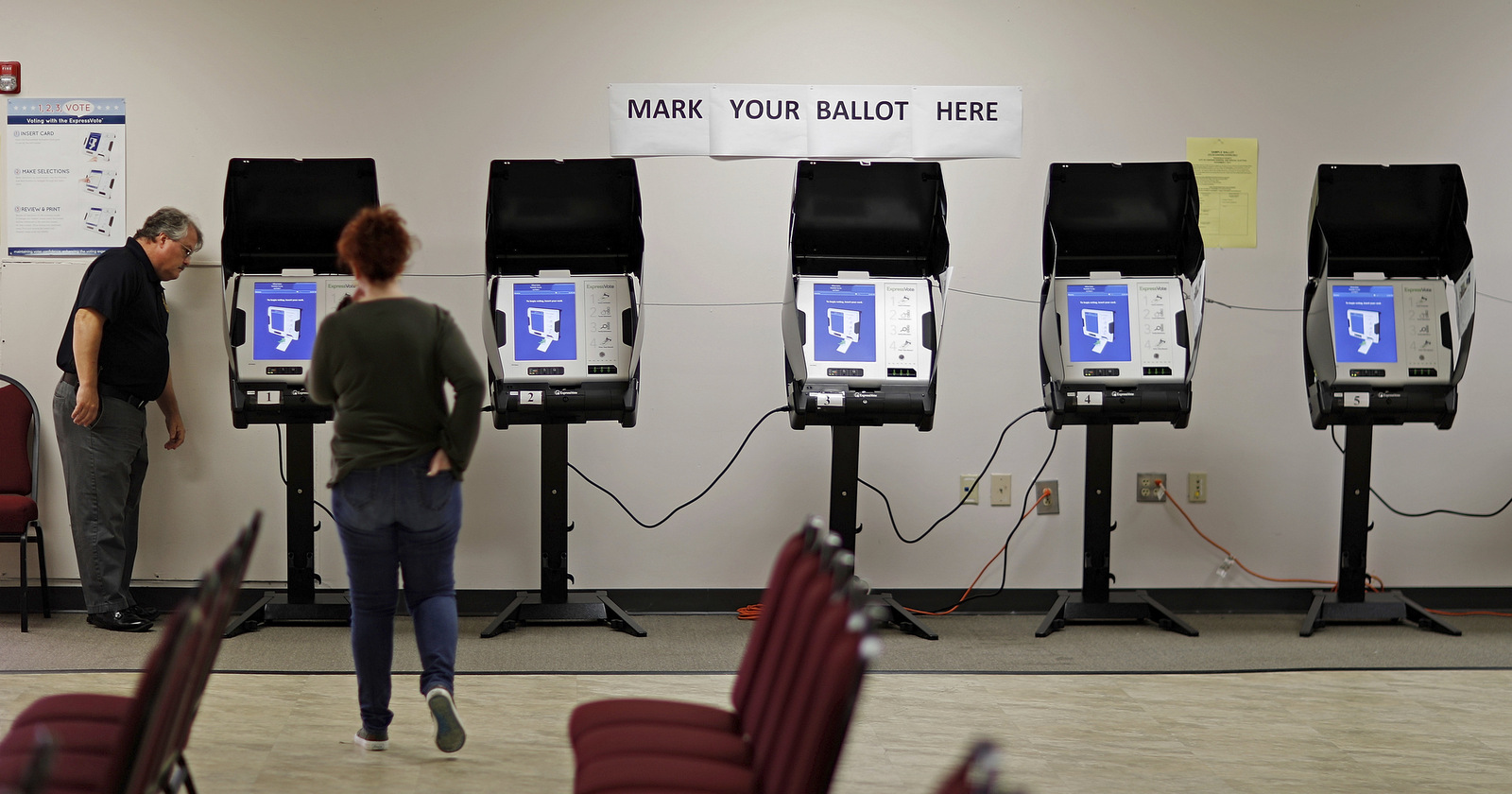SANTA CRUZ, CALIFORNIA (Analysis) — In the wake of last week’s off-off-year mini-election in the U.S., there’s been a lot of undisguised celebrating going on, even among the professionally impartial. Protests, parades, petitions, polls, tweets, and op-eds may be indicators of national mood, but elections remain the only official scorecard — our democracy’s periodic and infrequent opportunity for the public to weigh in, on the record. With America riven apart and in a state approaching an all-out internal Cold War, even the smallest “sampler menu” of official results takes on a Delphic dimension.
As an advocate for electoral integrity, I have long labored to bring public awareness to the security vulnerabilities — and susceptibility to fraud — of computerized American elections. Indeed, along with a number of perseverant colleagues, I have gone further and associated that susceptibility and its all-but-certain exploitation with the rightward veer of American politics during the computerized voting era. So it was no surprise that, from the moment Election 2017’s results started rolling in, I found myself on the receiving end of a fair number of “See, I told you there was nothing to worry about!” pokes.
However . . .
Lest anyone for a minute believe that the November 7 results – the Democratic sweep and across-the-board thumping of Brand Trump – provide assurance that our elections are now secure and that no one is targeting 2018 or 2020 for vote-count manipulation, please understand that that is seriously wishful thinking.
There are very good reasons that entities with the capacity to interfere with the counting process in these particular contests would have taken a pass, as it appears they did:
1) The actual victory margins in key contests were large – altering outcomes would have brought the “smell test” into play. Even in the “beacon of democracy,” where election theft is a “conspiracy theory” ranking somewhere between 9/11 Truth and alien abduction, there is a limit to how strange and shocking results can be without provoking suspicion and investigation. Reversing a 5 percent margin of victory would easily pass the smell test; a 15 percent margin might pose an unacceptable risk.
2) The election manipulator’s basic operational algorithm is a simple one: maximize victories and minimize losses, within bounds of acceptable levels of risk of detection. This calculus is, however, tempered by long-range strategic considerations. The 2017 prizes, significant as they may be, were a drop in the bucket compared to what is on the table in 2018. Given the now-heightened scrutiny of our election processes (and of course concerns about “the Russians”), it would make little strategic sense to trigger any red flags now – thereby putting urgency into the effort to button-up election security before 2018. Indeed, it would have been a gross strategic blunder.
3) Virginia had decertified its paperless machines (DREs), so that, unlike in the high-profile U.S. House election in Georgia’s 6th congressional district this summer, voting was entirely on paper and recounts/audits would have been in play in the event of “issues” with the count (anomalous results, exit poll/vote-count disparities, etc.). In fact, three state legislative elections are currently being recounted, with control of the Virginia House of Delegates in the balance. Crucially, election administration at the state level was — unlike in the key swing states in Election 2016 — under Democratic control.
4) New Jersey, although using non-verifiable DREs, was simply too big a margin – a win by Republican gubernatorial candidate Kim Guadagno would have failed the smell test spectacularly. The same can be said for the landslide vote in Maine approving the expansion of Medicaid.
Even for those down-ballot contests within smell-test range (i.e., approximately 10 percent margin of victory), the overarching analogy here is to the pool shark: missing makeable shots is part of the hustle, indeed essential to the hustle. Same for a poker cheat. If you win every hand, either no one will play with you or they will start making you play in short sleeves. You save those up-sleeve aces for the big pots. Elections 2018 and 2020 are not just the big pots — they are, given the fracturing of the country, for all the marbles.
Why a Democratic victory is taken as a sign of an honest election


Kelly Monroe, investigator with the Georgia secretary of state office, left, takes a look at a new voting machine being tested at a polling site in Conyers, Ga. Last summer, a security expert came across a gaping hole in Georgia’s election management system. The revelation prompted a lawsuit seeking to compel Georgia to toss all of its touchscreen voting machines and replace them with a system that provides a paper record of every ballot cast. Georgia is one of five states where no such record exists. Oct. 19, 2017 (AP/David Goldman)
We’ve been around this block many times. People can’t wait to say “There! You see, it’s all good now!” When Democrats win — whether it’s Obama in 2008 and 2012 (the mechanisms for which are explained in detail in my book, CODE RED: Computerized Election Theft and The New American Century) or in Election 2017 — the reflex assumption is that it proves U.S. elections are safe and secure.
This is, ironically, because virtually every piece of forensic evidence collected over the 15 years of the computerized vote-counting era points to distortions or manipulations favoring the more right-wing candidate or position. If some champion of the Right is so good at rigging, goes the thinking, and if elections could still be rigged, why would he/she/it ever, in a competitive election, allow the Democrat or left-winger to win? Ipso facto, the Election 2017 results prove rigging is not possible — so the thinking goes.
With the reward/risk ratio being so awful, rigging Tuesday night would have been, strategically speaking, idiotic. But we will have to spell this out over and over again, so strong is the desire to seize upon any apparent evidence that things are on the up and up.
Yesterday’s results should do nothing to reassure anyone about the security of our elections or diminish by a hair the urgency of our efforts to restore public and observable vote counting. Germany got it — and the Netherlands, Ireland, and now Norway. Each of these countries is now among those that count all or most of their national election ballots by hand in public. “Exceptional” America, on the other hand, seems to believe such care in safeguarding its democracy is not necessary. But we have already seen way too many cyber-aces drop out of cyber-sleeves to trust for a minute that this game is being played straight in the United States. If we do, we’re the perfect mark.
Election 2017: what (unrigged) democracy looks like


Fairfax County Virginia election workers conduct the official canvass of last night’s election returns at the Fairfax County Government Center, Nov. 8, 2017. (AP/Matt Barakat)
To me, ironically, the takeaway from Election 2017 is that this is exactly what elections in an observably counted United States would look like.
Yes, the elections took place mostly in Blue-ish America, but what was notable about the Democratic victories was that: 1) They significantly exceeded margins predicted by tracking polls; and 2) Where conducted, the unadjusted NEP exit polls were spot-on. These two indicators, for the reasons that follow, are just what we would expect to find in an honestly counted (i.e., non-rigged) election.
Throughout the era of computerized vote counting, unadjusted exit polls in competitive elections of national significance have exhibited a pervasive, unidirectional error. The exit-poll/vote-count disparity has been so pervasive and so unidirectional that we came to call it the “red shift” — the candidate or proposition to the right performs better in vote-counts than in exit polls. Last Tuesday, for the first time in the computerized voting era, the red shift vanished. The exit polls were – mirabile dictu – accurate.
Instead, we saw — especially in the paper ballot state of Virginia — a “blue shift” from most of the tracking polls (that is, the candidate to the left does better in the election than predicted by the polls). This too was essentially unprecedented in the computerized voting era in competitive elections of national significance.
Why would we expect to see that phenomenon in an honestly counted election? Because polling and elections constitute a classic feedback loop. As the computerized voting era unfolded, pollsters began to see their predictions going wrong — consistently predicting results to the left of electoral outcomes. The response by the pollsters — initially from Gallup, but it “worked” so well that it was adopted by the field — was to develop a sampling methodology known as the Likely Voter Cutoff Model (LVCM).
The LVCM operated to disproportionately exclude from polling samples voters from traditional Democratic constituencies (young, low-income, transient/renters/mobile, marginal). It employed a series of screening questions (e.g., “How long have you lived at your current residence?”) designed to “qualify” only the more stable/core/consistent voters — i.e., disproportionately Republicans — as respondents.
That this skewed sampling model “worked” so well was one strong, albeit indirect, piece of evidence that the vote-counts it was attempting to mirror had themselves been corrupted. In an honestly counted election, the LVCM would fail miserably, predicting results to the right of the vote-counts — and that is exactly what we saw in Election 2017.
Election 2017’s results speak volumes about the truth of our country and are worth real celebration. But anyone who draws the conclusion, based on those results, that 2018 and 2020 won’t be rigged is someone I’d love to see across a poker table. It is worth remembering that — both for Americans and for the life that shares the planet with us — the stakes of this game could not be higher.
Jonathan Simon is executive director of Election Defense Alliance and author of “CODE RED: Computerized Election Theft and The New American Century.” He blogs at www.CodeRed2014.com/blog.
<!–
–>
Source Article from http://www.mintpressnews.com/election-2017-what-an-honestly-counted-us-election-might-look-like/234586/
 RSS Feed
RSS Feed















 November 18th, 2017
November 18th, 2017  Awake Goy
Awake Goy 
 Posted in
Posted in  Tags:
Tags: 













